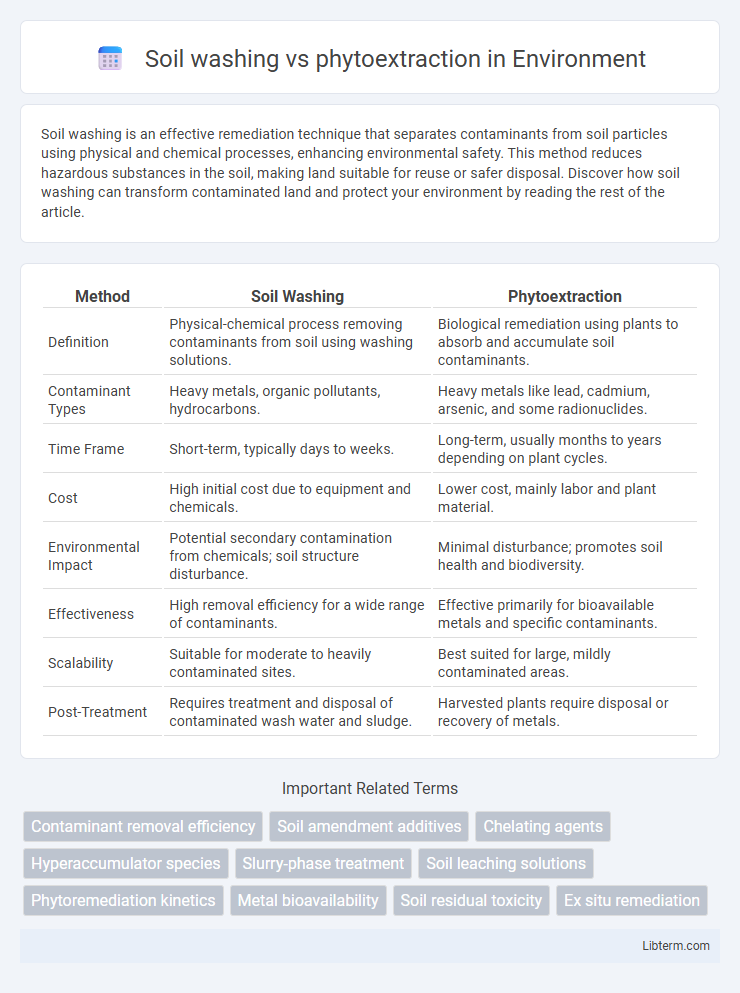Soil washing is an effective remediation technique that separates contaminants from soil particles using physical and chemical processes, enhancing environmental safety. This method reduces hazardous substances in the soil, making land suitable for reuse or safer disposal. Discover how soil washing can transform contaminated land and protect your environment by reading the rest of the article.
Table of Comparison
| Method | Soil Washing | Phytoextraction |
|---|---|---|
| Definition | Physical-chemical process removing contaminants from soil using washing solutions. | Biological remediation using plants to absorb and accumulate soil contaminants. |
| Contaminant Types | Heavy metals, organic pollutants, hydrocarbons. | Heavy metals like lead, cadmium, arsenic, and some radionuclides. |
| Time Frame | Short-term, typically days to weeks. | Long-term, usually months to years depending on plant cycles. |
| Cost | High initial cost due to equipment and chemicals. | Lower cost, mainly labor and plant material. |
| Environmental Impact | Potential secondary contamination from chemicals; soil structure disturbance. | Minimal disturbance; promotes soil health and biodiversity. |
| Effectiveness | High removal efficiency for a wide range of contaminants. | Effective primarily for bioavailable metals and specific contaminants. |
| Scalability | Suitable for moderate to heavily contaminated sites. | Best suited for large, mildly contaminated areas. |
| Post-Treatment | Requires treatment and disposal of contaminated wash water and sludge. | Harvested plants require disposal or recovery of metals. |
Introduction to Soil Remediation Techniques
Soil washing and phytoextraction are prominent soil remediation techniques used to address contaminated land. Soil washing employs physical and chemical processes to separate pollutants from soil particles, effectively reducing heavy metals and organic contaminants. Phytoextraction utilizes specific plants to absorb and concentrate contaminants like heavy metals from the soil, offering an environmentally friendly and sustainable remediation approach.
Understanding Soil Washing
Soil washing is an ex-situ remediation technique that uses water, chemical additives, and mechanical agitation to separate contaminants from soil particles, targeting heavy metals and organic pollutants. This process effectively reduces contaminant concentrations by physically removing pollutants, making the treated soil safer for reuse or disposal. Compared to phytoextraction, which relies on plants to absorb contaminants over time, soil washing offers faster decontamination, particularly in heavily polluted industrial sites.
What is Phytoextraction?
Phytoextraction is an environmentally friendly remediation technique that uses certain plants to absorb heavy metals and contaminants from soil through their root systems. This process stores pollutants in the plant biomass, which can be harvested and safely disposed of or recycled. Unlike soil washing, which involves physically removing contaminants with water and chemicals, phytoextraction leverages natural plant uptake to reduce soil toxicity over time.
Mechanisms of Contaminant Removal
Soil washing removes contaminants by physically separating pollutants through techniques like soil scrubbing and particle size separation, targeting heavy metals and hydrocarbons primarily adsorbed onto soil particles. Phytoextraction relies on hyperaccumulator plants that uptake contaminants such as metals through their roots, translocating and storing them in above-ground tissues for harvest. While soil washing physically relocates pollutants, phytoextraction biologically incorporates contaminants into plant biomass, enabling gradual remediation over time.
Effectiveness on Different Pollutants
Soil washing is highly effective for removing heavy metals and hydrophobic organic contaminants from soil by separating pollutants based on particle size and chemical properties, achieving rapid pollutant concentration reduction. Phytoextraction excels in targeting heavy metals such as cadmium, lead, and zinc through plant uptake and accumulates contaminants in harvestable biomass, although it requires longer time frames and is less effective for organic pollutants. Both methods offer complementary remediation strategies, with soil washing providing immediate pollutant removal and phytoextraction enabling sustainable in situ treatment primarily for metal contaminants.
Environmental Impact Comparison
Soil washing physically removes contaminants from soil using water and chemical additives, resulting in wastewater that requires treatment but effectively reduces pollutant concentrations quickly. Phytoextraction employs specific plants to absorb heavy metals and toxins over time, promoting natural bioremediation with minimal disruption to soil structure and ecosystem health. While soil washing offers rapid decontamination, phytoextraction provides a more sustainable and eco-friendly approach with lower carbon emissions and reduced chemical usage.
Cost Analysis: Soil Washing vs Phytoextraction
Soil washing typically incurs higher upfront costs due to the need for specialized equipment and chemical reagents, but it offers rapid contaminant removal, reducing long-term site management expenses. Phytoextraction presents lower initial investment and operational costs by utilizing plants to absorb pollutants, yet requires extended timeframes for effective remediation and ongoing maintenance, potentially increasing total lifecycle costs. Choosing between these methods depends on balancing time sensitivity, contaminant type, soil characteristics, and budget constraints to optimize overall cost-effectiveness.
Timeframe for Remediation Success
Soil washing achieves remediation success rapidly, often within weeks to months, by physically removing contaminants through a rigorous treatment process. Phytoextraction requires an extended timeframe, typically several growing seasons or years, as plants uptake contaminants gradually from the soil. The choice between these methods depends heavily on the urgency of site remediation and contaminant concentration levels.
Case Studies and Practical Applications
Soil washing involves using chemical solutions to remove contaminants from soil and has been effectively applied in industrial sites contaminated with heavy metals, achieving rapid decontamination in areas like the Tar Creek Superfund site in Oklahoma. Phytoextraction uses hyperaccumulator plants to absorb pollutants from soil over multiple growing seasons, demonstrated in case studies such as the use of Brassica juncea to remediate lead-contaminated soils in India. Practical applications show soil washing offers faster results for heavily polluted soils, while phytoextraction provides a cost-effective, environmentally sustainable option for large, moderately contaminated sites.
Choosing the Right Method for Your Site
Soil washing effectively removes heavy metals and organic contaminants by physically separating pollutants, making it ideal for sites with high contamination levels and limited vegetation. Phytoextraction uses metal-accumulating plants to absorb contaminants over time, suitable for large, less severely polluted areas with longer remediation timelines. Assessing site-specific factors such as contaminant type, concentration, soil properties, and time constraints is crucial for selecting the most effective remediation strategy.
Soil washing Infographic

 libterm.com
libterm.com